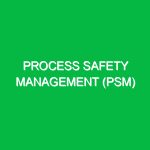Refinery operations play a pivotal role in the energy sector, converting crude oil into valuable products such as gasoline, diesel, and various petrochemicals. However, these processes come with inherent risks that necessitate rigorous safety considerations. In the Health, Safety, and Environment (HSE) domain, understanding and implementing effective safety measures is not just a regulatory requirement but a moral obligation to protect workers, the community, and the environment. This article delves into the critical safety considerations in refinery operations, exploring potential hazards, safety precautions, industry regulations, and best practices.
The Importance of Safety Considerations in Refinery Operations
Safety considerations in refinery operations are crucial for several reasons. First and foremost, refineries often handle highly flammable and toxic substances. A single lapse in safety can lead to catastrophic events, including explosions, fires, and toxic releases, which can have devastating impacts on human health and the ecosystem. Moreover, maintaining a robust safety culture enhances operational efficiency and mitigates financial losses associated with accidents and regulatory fines.
In my time working at a major refinery, I vividly recall an incident where a small leak in a pipeline escalated into a significant safety issue. Thankfully, quick action and adherence to safety protocols prevented any injuries. This experience underscores the critical need for comprehensive safety measures in refinery operations.
Identifying Hazards and Risks in Refinery Operations
Potential Hazards
Refinery operations encompass a wide range of activities, each with unique hazards. Some of the most common hazards include:
1. Fire and Explosion Risks
Refineries process highly volatile substances, making them susceptible to fires and explosions. Factors contributing to these risks include equipment failure, human error, and maintenance lapses. For instance, a build-up of flammable vapors in an enclosed area can create an explosive atmosphere if not properly managed.
2. Chemical Exposure
Workers at refineries are often exposed to hazardous chemicals, including benzene, hydrogen sulfide, and sulfur dioxide. Prolonged exposure can lead to severe health issues, including respiratory problems and long-term chronic conditions.
3. Mechanical Failures
Equipment used in refineries is subject to wear and tear, and mechanical failures can result in leaks, spills, or equipment malfunctions. Regular maintenance and inspections are crucial to mitigate these risks.
4. Environmental Hazards
Refinery operations can lead to environmental contamination through spills or emissions. These incidents can harm local ecosystems and result in significant regulatory fines.
Assessing Risks
Conducting a comprehensive risk assessment is essential in identifying potential hazards in refinery operations. This process involves evaluating the likelihood and consequence of various risks, enabling the implementation of tailored safety measures. Techniques such as Hazard and Operability Studies (HAZOP) and Failure Mode and Effects Analysis (FMEA) can provide valuable insights into potential vulnerabilities within the refinery’s operations.
Safety Precautions and Best Practices
Implementing Safety Measures
To mitigate the hazards identified, refineries must adopt a multifaceted safety approach. Here are some best practices that can significantly enhance safety considerations:
1. Training and Education
Regular training sessions for refinery personnel are vital. Employees should be well-versed in emergency response procedures, equipment operation, and hazard recognition. For instance, I remember attending a safety drill that simulated a fire outbreak. The exercise not only reinforced our training but also highlighted areas for improvement in our emergency response plan.
2. Routine Inspections and Maintenance
Establishing a schedule for routine inspections and maintenance of equipment can help identify potential failures before they escalate into hazardous situations. Utilizing predictive maintenance technologies can also enhance the reliability of refinery operations.
3. Safety Equipment and Gear
Personal protective equipment (PPE) is essential for safeguarding workers against chemical exposure and physical hazards. Ensuring that all employees have access to and consistently use the appropriate PPE is a fundamental safety measure.
4. Emergency Preparedness Plans
Refineries should develop and regularly update emergency preparedness plans. These plans should detail procedures for various potential incidents, including fires, chemical spills, and natural disasters. Conducting regular drills can ensure that all employees know their roles during an emergency.
5. Incident Reporting and Analysis
Encouraging a culture of open communication regarding safety concerns can help identify potential hazards before they lead to incidents. Implementing a robust incident reporting system allows for thorough analysis and learning from past mistakes, ultimately improving safety protocols.
Regulations and Standards Governing Safety in Refinery Operations
In the realm of refinery operations, several regulations and standards dictate safety considerations. Understanding these regulations is crucial for compliance and risk mitigation. Key regulatory bodies include:
1. Occupational Safety and Health Administration (OSHA)
OSHA sets and enforces standards to ensure safe working conditions in various industries, including refineries. Compliance with OSHA regulations helps mitigate risks associated with workplace hazards.
2. Environmental Protection Agency (EPA)
The EPA establishes regulations to protect the environment from contamination and pollution. Refineries must adhere to these regulations to minimize their environmental impact and avoid legal repercussions.
3. National Fire Protection Association (NFPA)
The NFPA develops codes and standards related to fire safety. Refineries must implement NFPA standards to prevent fire hazards and ensure the safety of personnel and equipment.
4. American Petroleum Institute (API)
The API provides guidelines and best practices for the oil and gas industry. These standards cover various aspects of refinery operations, including safety considerations and environmental practices.
Conclusion
In summary, safety considerations in refinery operations are paramount to safeguarding workers, the environment, and the facility itself. By identifying potential hazards and implementing effective safety measures, refineries can create a culture of safety that minimizes risks and protects all stakeholders involved. As we continue to navigate the complexities of refinery operations, prioritizing health, safety, and environmental concerns will remain essential. The lessons learned from past incidents highlight the need for constant vigilance and improvement in safety protocols, ensuring a safer future for everyone involved in these critical operations.


